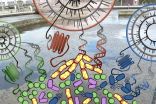Prehistoric conflict hastened human brain's capacity for collaboration, study says
2014-11-26
(Press-News.org) KNOXVILLE - Warfare not only hastened human technological progress and vast social and political changes, but may have greatly contributed to the evolutionary emergence of humans' high intelligence and ability to work together toward common goals, according to a new study from the National Institute for Mathematical and Biological Synthesis (NIMBioS).
How humans evolved high intelligence, required for complex collaborative activities, despite the various costs of having a big brain has long puzzled evolutionary biologists. While the human brain represents only about two percent of the body's weight, it uses about 20 percent of the energy consumed. Other costs of having a large brain include a need for extended parental care due to a long growth period, difficulties giving birth to larger-headed babies, and some mental illnesses associated with brain complexity. So how did the human brain evolve to become so large and complex?
Another long-running question is how did humans evolve strong innate preferences for cooperative behavior, as cooperative behavior is vulnerable to exploitation by cheaters and "free-riders." A free-rider doesn't contribute or cooperate and thereby undermines the effectiveness of the group's collaborative effort, something scientists call "the collective action problem." Thus, collaborative behavior is expected to be rare, and indeed, in animals it is typically limited to close relatives. Humans, however, are a unique species where collaboration is widespread and not limited to relatives.
In the new study published in the Journal of Royal Society Interface, lead author Sergey Gavrilets, a professor of ecology and evolutionary biology and mathematics at the University of Tennessee, Knoxville, and NIMBioS associate director for scientific activities, developed a mathematical model that offers answers to both evolutionary puzzles.
The model shows that intelligence and cooperative behavior can co-evolve to solve the problem of collective action in groups and to overcome the costs of having a large brain.
The research points to the types of collective actions that are most effective at hastening collaboration. According to the model, collaborative ability evolves easiest if there is direct conflict or warfare between groups, what Gavrilets calls "us vs. them" activities. In contrast, collective activities, such as defending against predators or hunting for food, which Gavrilets calls "us vs. nature" activities, are much less likely to result in a significant increase in collaborative abilities.
The study also predicts that if high collaborative ability cannot evolve, perhaps for example because the costs of having a big brain are too high, the species will harbor a small proportion of individuals with a genetic predisposition to perform individually-costly but group-beneficial acts.
In addition, the model challenges influential theories on when large-game hunting and within-group coalitions first appeared in humans. Some scientists say that within-group coalitions and collaborative hunting came first and then subsequently created conditions for the evolution of collaboration in between-group conflicts. Yet, Gavrilets' model shows the opposite: that collaboration in between-group fighting preceded both within-group coalitions and collaborative hunting.
"Our ability to effectively collaborate with others is largely responsible for what our species came to be. The big question is how this ability first evolved when there are large metabolic and physiological costs related to human brain size and when collaboration can be easily undermined by free riders. The model offers an answer which emphasizes the role of between-group conflicts in shaping unique human features," Gavrilets said.
INFORMATION:
Citation: Gavrilets S. 2014. Collective action and the collaborative brain. Journal of the Royal Society Interface. Published online 26 November 2014. http://dx.doi.org/10.1098/rsif.2014.1067
The National Institute for Mathematical and Biological Synthesis is an NSF-supported center that brings together researchers from around the world to collaborate across disciplinary boundaries to investigate solutions to basic and applied problems in the life sciences.
ELSE PRESS RELEASES FROM THIS DATE:
2014-11-26
Published in the journal Nature, the discovery could revolutionise fuel cells and other hydrogen-based technologies as they require a barrier that only allow protons - hydrogen atoms stripped off their electrons - to pass through.
In addition, graphene membranes could be used to sieve hydrogen gas out of the atmosphere, where it is present in minute quantities, creating the possibility of electric generators powered by air.
One-atom thick material graphene, first isolated and explored in 2004 by a team at The University of Manchester, is renowned for its barrier properties, ...
2014-11-26
NGC 3532 is a bright open cluster located some 1300 light-years away in the constellation of Carina(The Keel of the ship Argo). It is informally known as the Wishing Well Cluster, as it resembles scattered silver coins which have been dropped into a well. It is also referred to as the Football Cluster, although how appropriate this is depends on which side of the Atlantic you live. It acquired the name because of its oval shape, which citizens of rugby-playing nations might see as resembling a rugby ball.
This very bright star cluster is easily seen with the naked eye ...
2014-11-26
Jülich, 26 November 2014 - In metals such as copper or aluminium, so-called conduction electrons are able to move around freely, in the same way as particles in a gas or a liquid. If, however, impurities are implanted into the metal's crystal lattice, the electrons cluster together in a uniform pattern around the point of interference, resembling the ripples that occur when a stone is thrown into a pool of water. Scientists in Jülich have, with the help of computer simulations, now discovered a combination of materials that strengthens these Friedel oscillations ...
2014-11-26
The Luxembourg Centre for Systems Biomedicine (LCSB) has succeeded for the first time in describing the complex relationships within an ecosystem in unprecedented detail. For their work, carried out in collaboration with US and Luxembourg partners, their model ecosystem was a "biological wastewater treatment plant". In it live numerous species of bacteria which are involved in the wastewater purification process.
LCSB director Prof. Dr. Rudi Balling stresses the medical importance of these research efforts: "Bacterial ecosystems also play a major role in our health. ...
2014-11-26
Although the van der Waals force was discovered around 150 years ago, it is still difficult to quantify when predicting the behaviour of solids, liquids, and molecules. Precise measurements were only possible up to now for single atoms or macroscopic objects. However, the van der Waals forces are particularly important at intermediate size, where they crucially co-determine the behaviour of complex molecules, such as biomolecules and proteins. They are also responsible for the functioning of certain adhesives and are the reason why geckos can adhere so amazingly well to ...
2014-11-26
This news release is available in French. The way people with autism spectrum disorder (ASD) gather information - not the judgement process itself - might explain why they gain different perceptions from peoples' faces, according to a new study from Hôpital Rivière-des-Prairies and the University of Montreal. "The evaluation of an individual's face is a rapid process that influences our future relationship with the individual," said Baudouin Forgeot d'Arc, lead author of the study. "By studying these judgments, we wanted to better understand how people with ...
2014-11-26
The precise movements of a young hammerhead shark have been tracked for the first time and are published in the open access journal Animal Biotelemetry. The study, which ran over a 10-month period, reveals important gaps in current efforts to protect these endangered sharks and suggests key locations that should be protected to help the survival of the species.
Hammerhead sharks, which have recently received new protections from the UN Convention on the Conservation of Migratory Species of Wild Animals, are experiencing drastic population declines in excess of 90% in ...
2014-11-26
The expression of a gene involved in female birds' color vision is linked to the evolution of colorful plumage in males, reports a new study from the University of Chicago. The findings, published Nov. 26 in the Proceedings of the Royal Society B, confirm the essential role of female color perception in mate selection and sexual dimorphism.
"This is the first time an aspect of the visual system in birds has been directly associated with plumage evolution," said Natasha Bloch, PhD, who authored the study while a graduate student in ecology & evolution at the University ...
2014-11-26
Deaf teenagers have better reading skills if they were identified as deaf by the time they were nine months old, research from the University of Southampton has shown.
The Southampton team has been studying the development of a group of children who were identified with permanent childhood hearing impairment (PCHI) at a very early age in a pilot screening programme conducted in Southampton and London in the 1990s.
Follow up assessments when the children were aged eight showed those who were screened at birth had better language skills than those children who were not ...
2014-11-26
Rheumatic heart disease (RHD) - the most common acquired heart disease in children in many countries of the world - is being neglected and poorly treated, according to new findings from the Global Rheumatic Heart Disease Registry (the REMEDY study), published online today (Wednesday) in the European Heart Journal [1].
RHD accounts for up to 1.4 million deaths every year, with the highest numbers of people affected by it and dying occurring in low and middle-income countries. It is triggered by rheumatic fever (RF) that can be prevented and controlled. RF is preceded by ...
LAST 30 PRESS RELEASES:
[Press-News.org] Prehistoric conflict hastened human brain's capacity for collaboration, study says




